*This post may contain affiliate links. Read more »
Made with translucent glass noodles, crunchy vegetables, and a medley of aromatic Thai sauces, this stir-fried noodle delight is a symphony of sweet, salty, and tangy notes. Whether you're a seasoned vegan or just curious to explore new plant-based options, this dish will make you and your family graduate from the Harvard University of flavor (I am pretty sure that’s a thing) and ascend to a celestial realm of flavor.
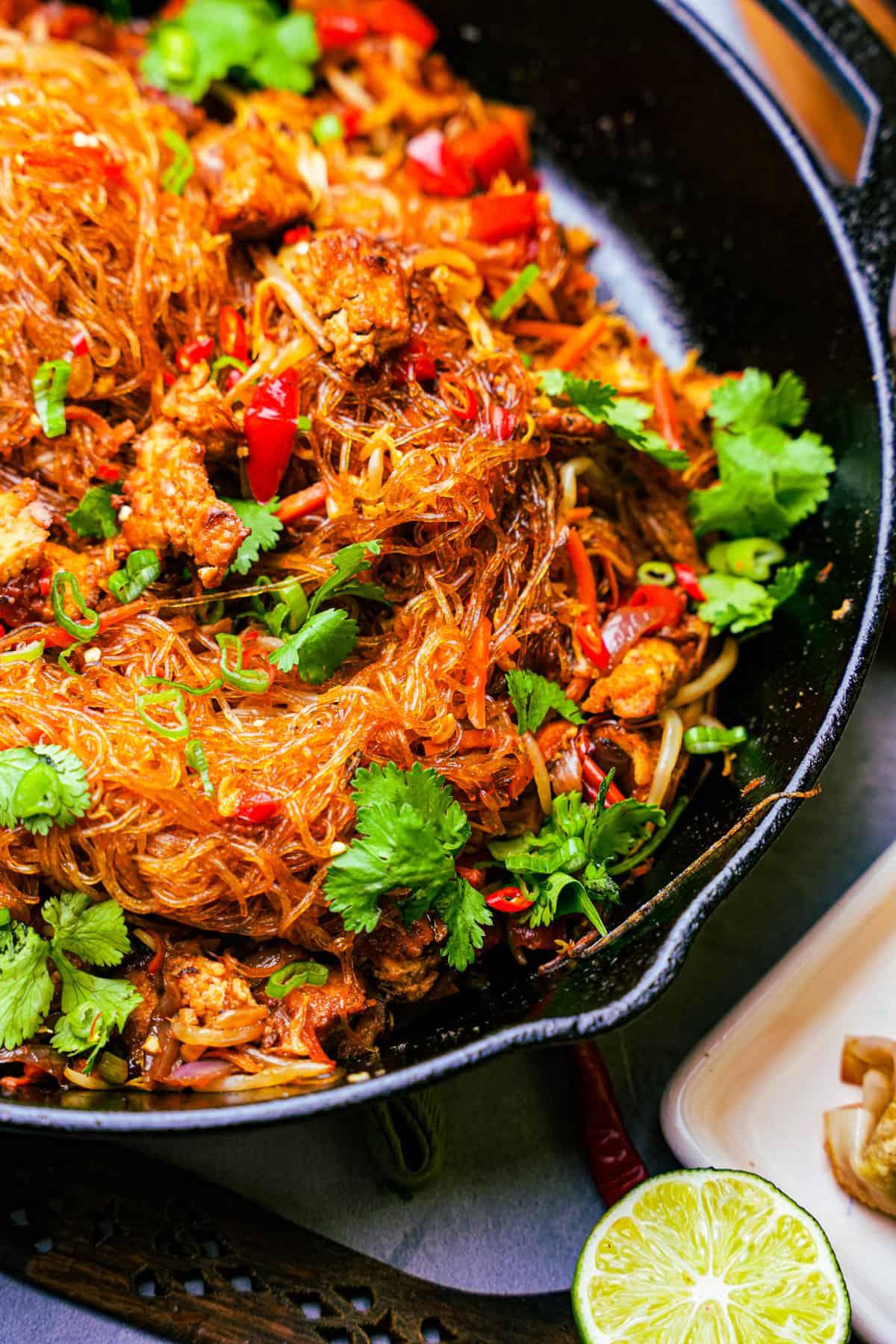

Enter your email & I'll send it to your inbox. Plus, get great new recipes from me every week!
By submitting this form, you consent to receive emails from Cinnamon Snail.
This steamy bowl of perfect noodles also happens to be completely gluten-free, and you can drizzle the heck out of it with my nam prik pao or nam jim jaew, or kick up the flavor with a spoonful of tom yum paste!
So, let's dive into the world of vegan Pad Woon Sen and discover how this classic Thai dish is even better as a delectable plant-based masterpiece!
Jump to:
- 🥰Why you are going to adore the ever-loving heck outta this recipe
- What is Pad Woon Sen?
- 🌶️Notable ingredients in this recipe and substitutions
- 📖How to make perfect pad woon sen
- 💡Serving Ideas
- 👉Top tip
- 🤷♀️Recipe FAQs
- ✌️Other dishes that go great with pad woon sen:
- Pad woon sen (Thai stir-fried glass noodles)
🥰Why you are going to adore the ever-loving heck outta this recipe
- Perfect for Meal Prep: Pad Woon Sen can be a fantastic option for meal prep, allowing for easy and convenient planning ahead. Glass noodles, being transparent and thin, tend to retain their texture and taste well even when stored. When properly stored in an airtight container in the refrigerator, your vegan Pad Woon Sen can stay fresh for up to four days, allowing you to enjoy leftovers for several meals throughout the week.
- Quick and Easy: This recipe makes cooking Pad Woon Sen a breeze, with simple step-by-step instructions with pictures. You are gonna love how fast this flavorful, healthy meal comes together. You can have dinner on the table in less than 30 minutes, so while it's coming together you can whip up some rice paper salad or charred eggplant salad to accompany it
- Great for you, and great for animals who aren’t killed to make this: This recipe is healthy, plant-based, protein-rich, and naturally gluten-free.
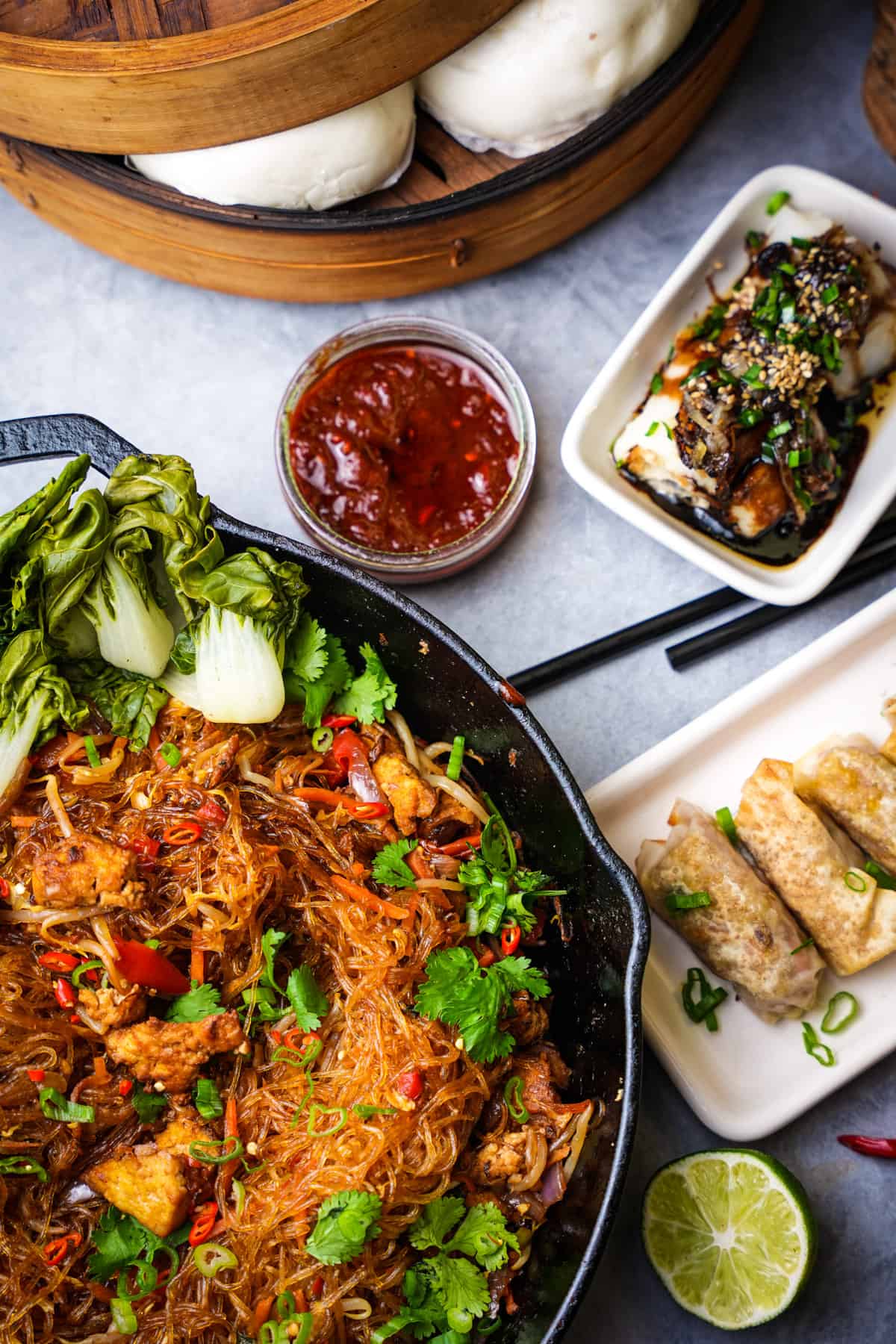


🙌 Learn to make restaurant-quality Thai food
This guide to my most popular vegan Thai recipes is 100% FREE, & you'll love the actual heck out of it 🥰
What is Pad Woon Sen?
Different from the wide rice noodles that famous Thai dishes like pad kee mao and pad see ew are made from, Pad Woon Sen, also known as Pad Woonsen or Pad Glass Noodles, is made with bean thread noodles, which are also known as cellophane noodles or glass noodles. The noodles are made from mung bean starch and when cooked are transparent and thin, with a slightly chewy, stretchy texture.
Vegetarian Pad Woon Sen typically includes a combination of glass noodles, protein (such as fried beancurd or seitan), vegetables (such as carrots, cabbage, bell peppers, and onions), and is often flavored with Thai sauces such as vegetarian oyster sauce, soy sauce, and a touch of sweetness from sugar or palm sugar. It is cooked quickly in a hot wok or pan, with ingredients stir-fried together until they are cooked through, and the flavors are well blended.
Pad Woon Sen is known for its light and delicate flavors, with a balance of sweet, salty, and tangy notes. It is garnished with cilantro, green onions, and lime wedges, and may be served with a side of chili flakes or sliced fresh Thai chili for those who prefer a spicier kick.
🌶️Notable ingredients in this recipe and substitutions
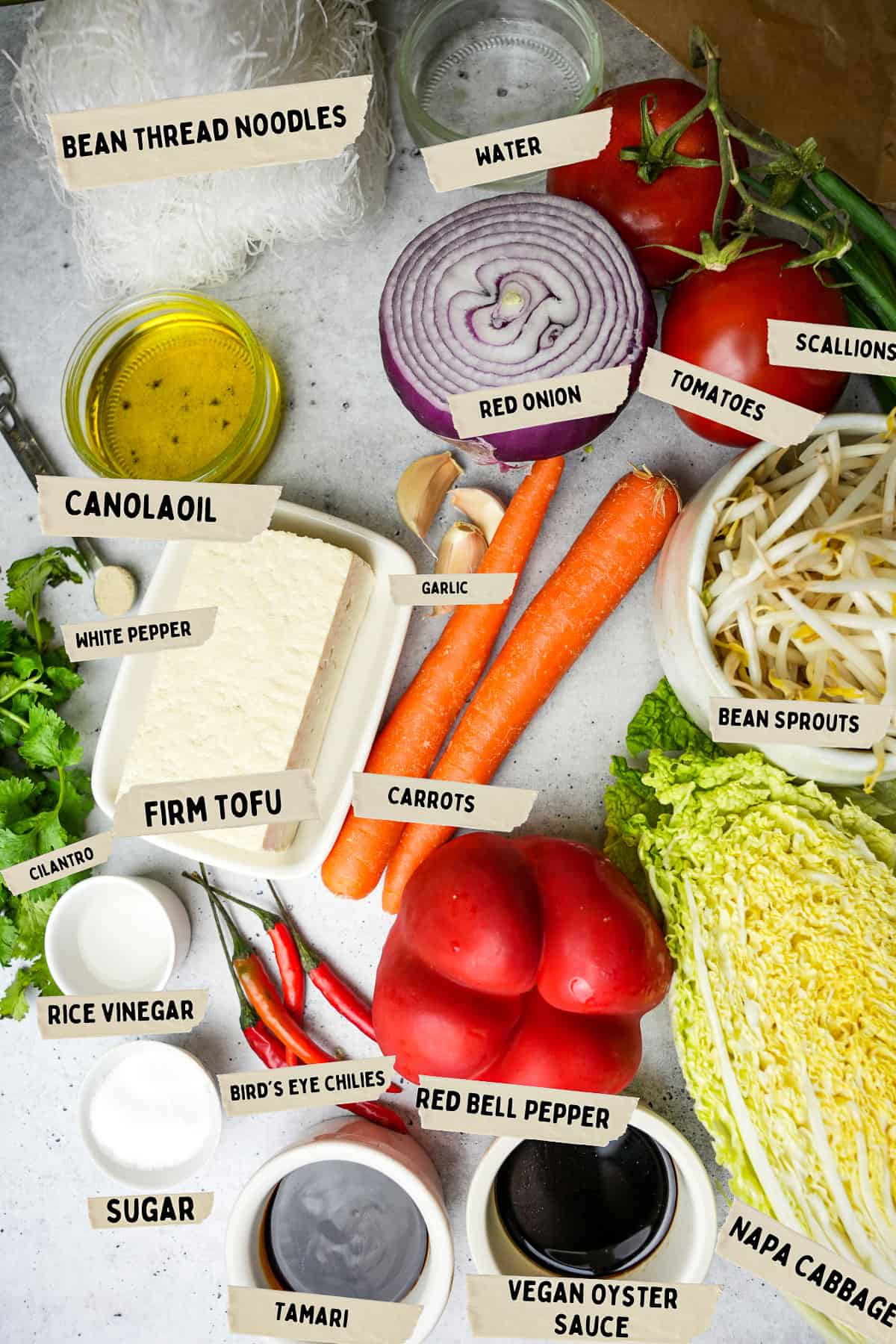
- Bean thread noodles: Bean thread noodles, also known as glass noodles or cellophane noodles, are made from mung bean starch and have a translucent appearance when cooked. If you can't find bean thread noodles, sweet potato noodles or rice noodles are great alternatives, and if you get thin ones, they are prepared exactly like the bean thread noodles. You can also make healthy vegetable-based noodles with a spiralizer out of sweet potato, zucchini, or celery root to use in this recipe. Just be careful not to over-cook them.
- Tofu: Torn pan fried extra-firm Tofu adds a satisfying chicken-like texture, with a hearty, meaty bite. Making the dish with tofu keeps it gluten-free. Otherwise, if you don’t mind gluten and would like to use homemade seitan, check out my recipe for making vegan chicken, and use that in place of the tofu in this recipe. If you really want to master the art of vegan meat, check out my cooking class and learn the best ways to make seitan from scratch. It's a fantastic way to customize your Pad Woon Sen and elevate it to the next level of deliciousness!
- Vegan oyster sauce: Vegan (or sometimes just labeled vegetarian) oyster sauce typically contains ingredients such as mushrooms, soy sauce, and seasonings, giving it a similar savory and umami flavor profile. I use it in everything from mee rebus to chee cheong fun. Most Asian food stores carry it, and you can also source it online. If you can't get vegan oyster sauce, you can use mushroom sauce or Nước Chấm as a substitute, providing a similar umami-rich taste to your dishes. Always check the label and ingredients to ensure that it is vegan and meets your dietary preferences.
- Bird’s Eye chilies: Bird's eye chilies, also known as Thai chilies, are small, fiery, somewhat fruity-tasting peppers that pack a punch. They are commonly used in Southeast Asian cuisines to add flavorful spice to dishes. If you can't find bird's eye chilies, some substitutes that you can use are frenso chilies (which are a milder but tasty option), serrano peppers, or cayenne peppers, depending on your desired level of spiciness. Just be sure to adjust the quantity according to your heat tolerance!
See the recipe card at the bottom of this page for the complete list of ingredients and their quantities.
📖How to make perfect pad woon sen
You wanna see how this bowl of heavenly noodles and veggies gets made? Check out these cooking instructions with photos. Or you can follow along with the easy-to-print recipe card towards the bottom of this page.
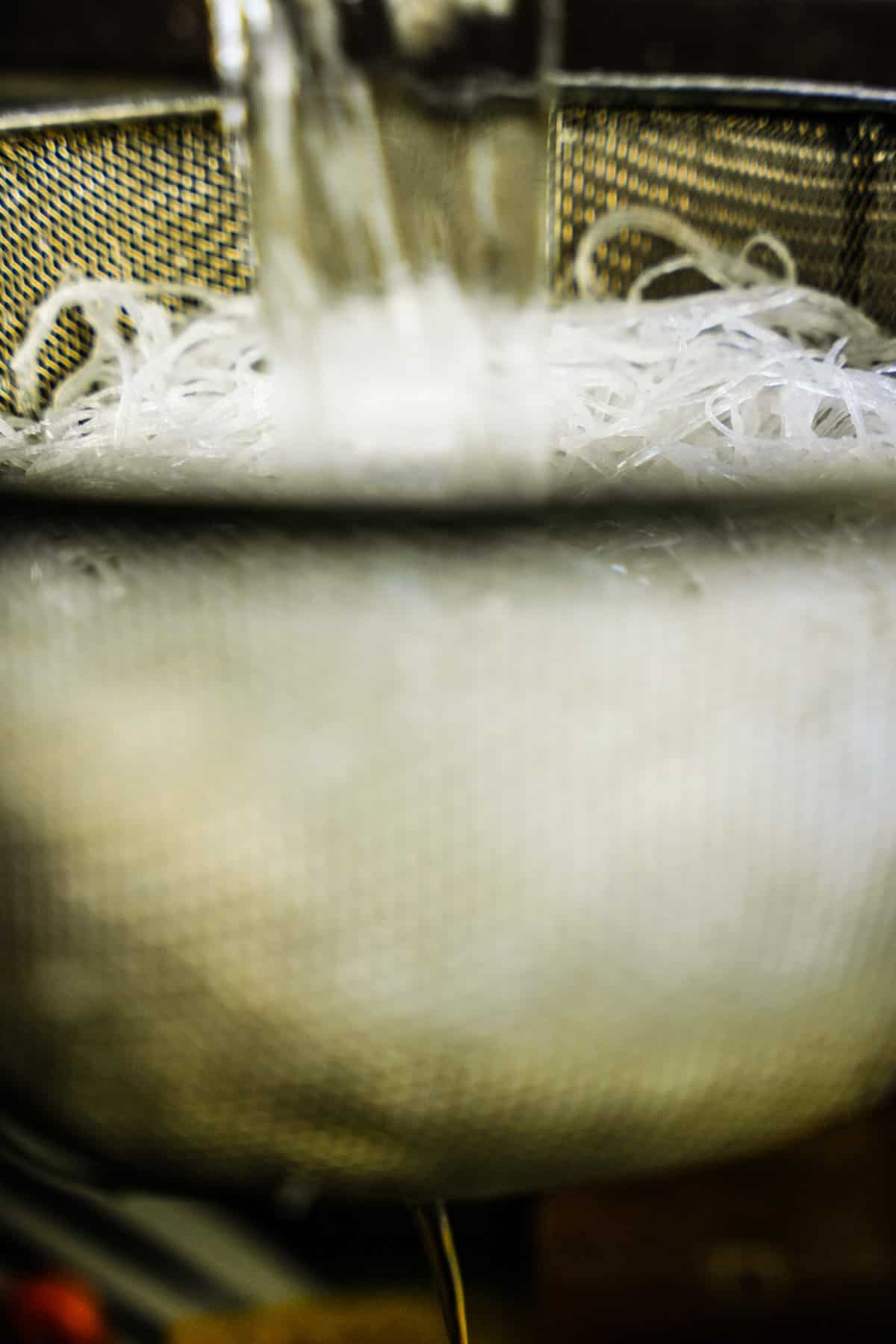
Step 1
Soak the dried bean thread noodles in warm water for 8-10 minutes until they are just pliable and soft. Drain them in a colander and set them aside.
Tip: Avoid over-soaking the noodles, as they can become too soft and mushy.
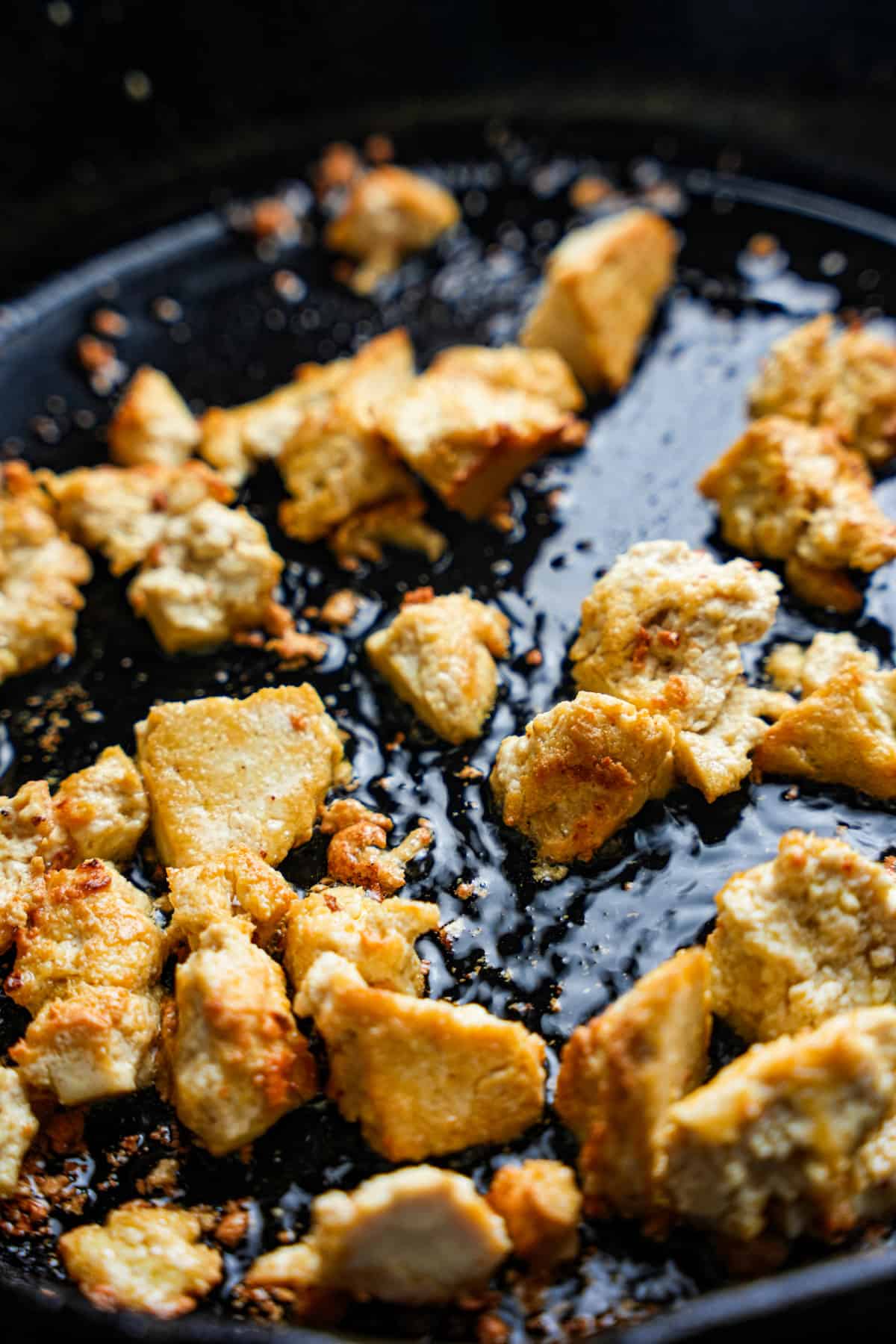
Step 2
Heat canola or vegetable oil in a large wok or pan over medium-high heat. Add torn tofu to the pan and stir-fry for 8-9 minutes until they are lightly golden and crispy. Tip: Pat the tofu dry with a paper towel before adding it to the pan to remove excess moisture and promote crispiness.
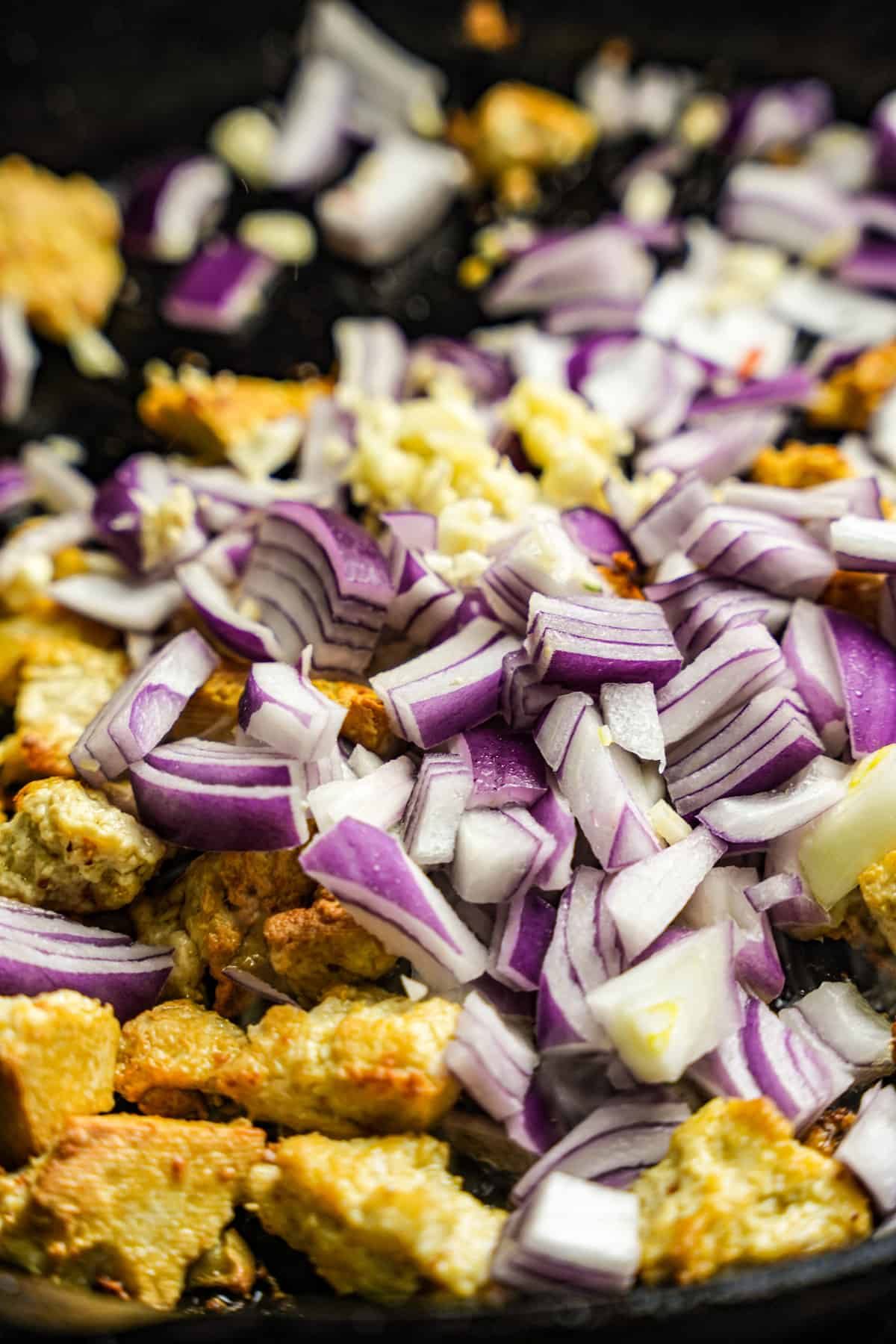
Step 3
Add minced garlic and red onion to the pan and stir-fry with the tofu for 1-2 minutes until fragrant.
Tip: Keep stirring constantly to prevent the small-cut garlic from burning.
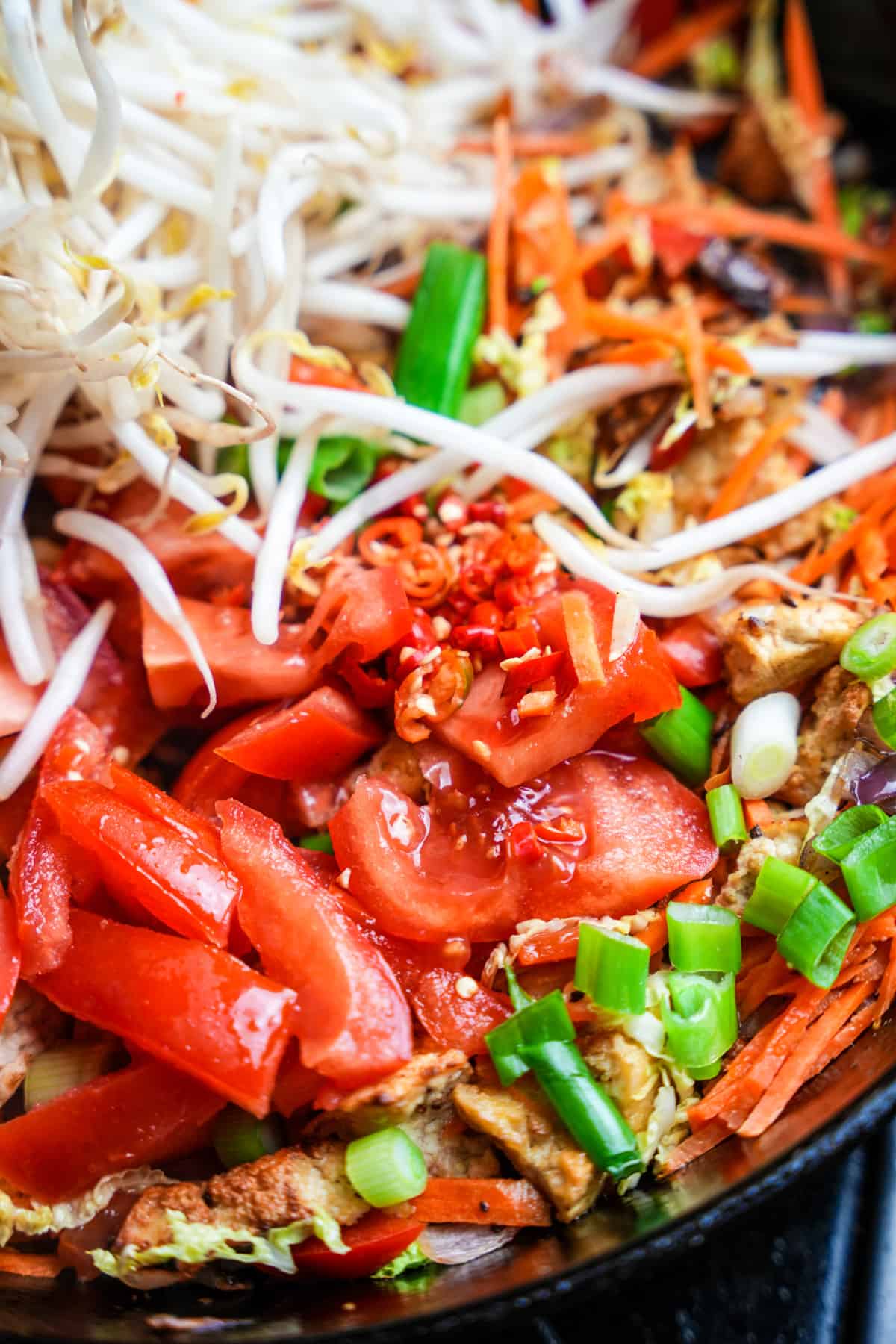
Step 4
Add julienne-cut carrots, sliced red bell pepper, shredded Napa cabbage, tomatoes, bean sprouts, bird's eye chilies, and scallions to the pan. Stir-fry for another 2-3 minutes until the vegetables are slightly softened. Tip: You can adjust the cooking time according to your preference for the desired level of crunchiness in the vegetables.
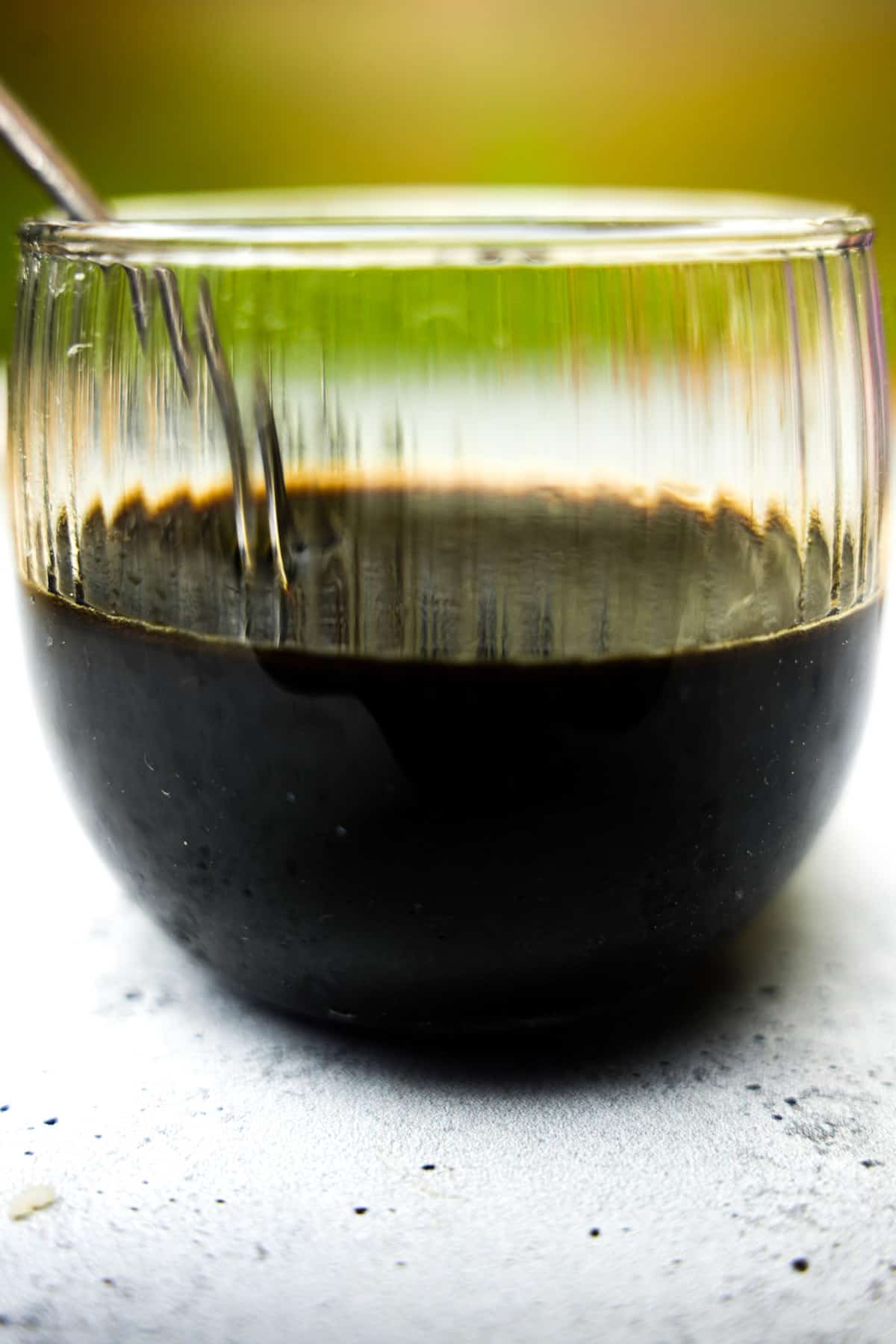
Step 5
Whisk together tamari, vegan oyster sauce, rice vinegar, sugar, water, and ground white pepper in a small bowl to make the sauce.
Tip: Taste the sauce and adjust the seasoning according to your preference.
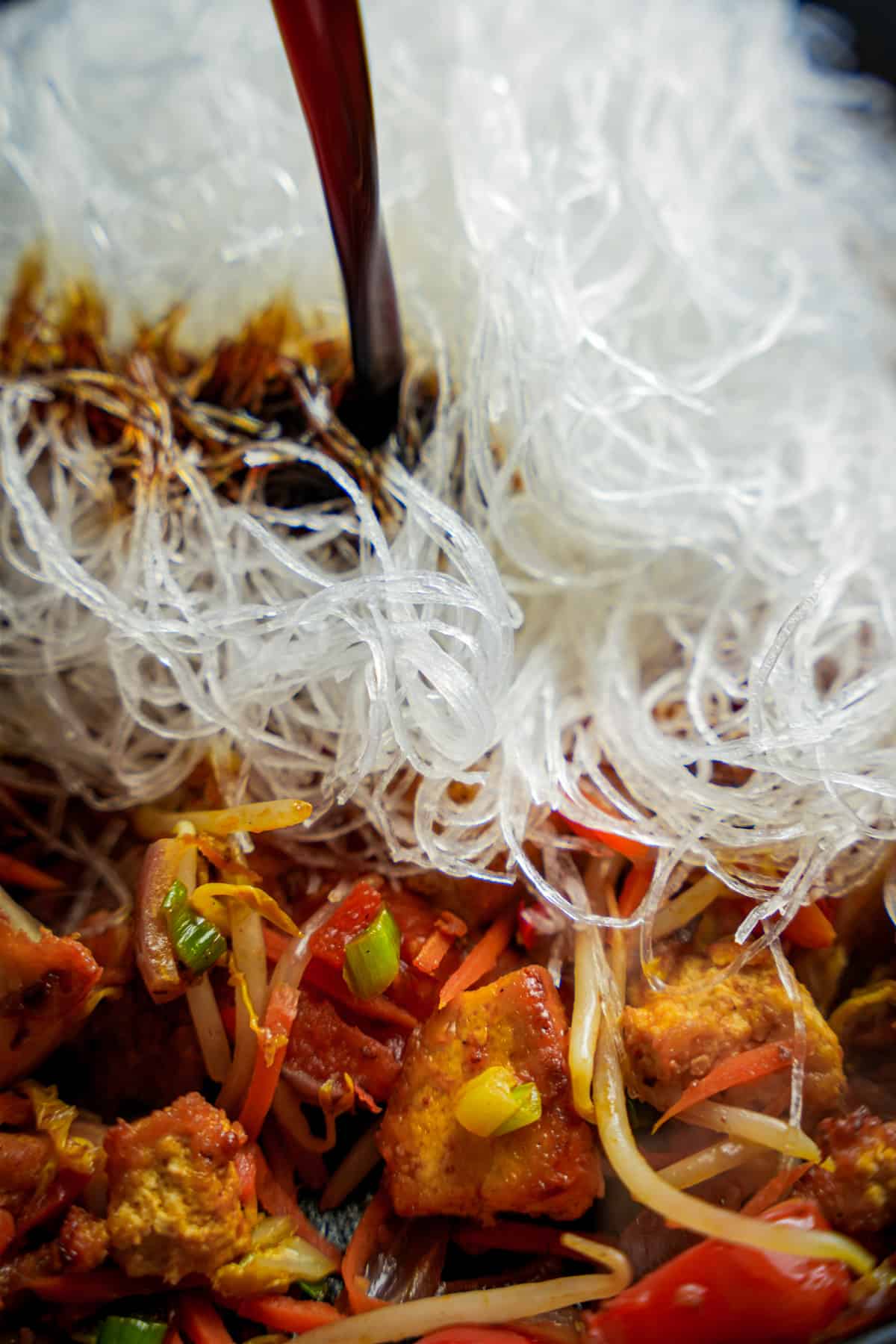
Step 6
Pour the sauce over the vegetables in the pan and add the drained bean thread noodles. Stir-fry everything together for another 2-3 minutes until the noodles are heated through, and the sauce is well distributed. Tip: Use tongs or chopsticks to toss and coat the noodles evenly with the sauce.
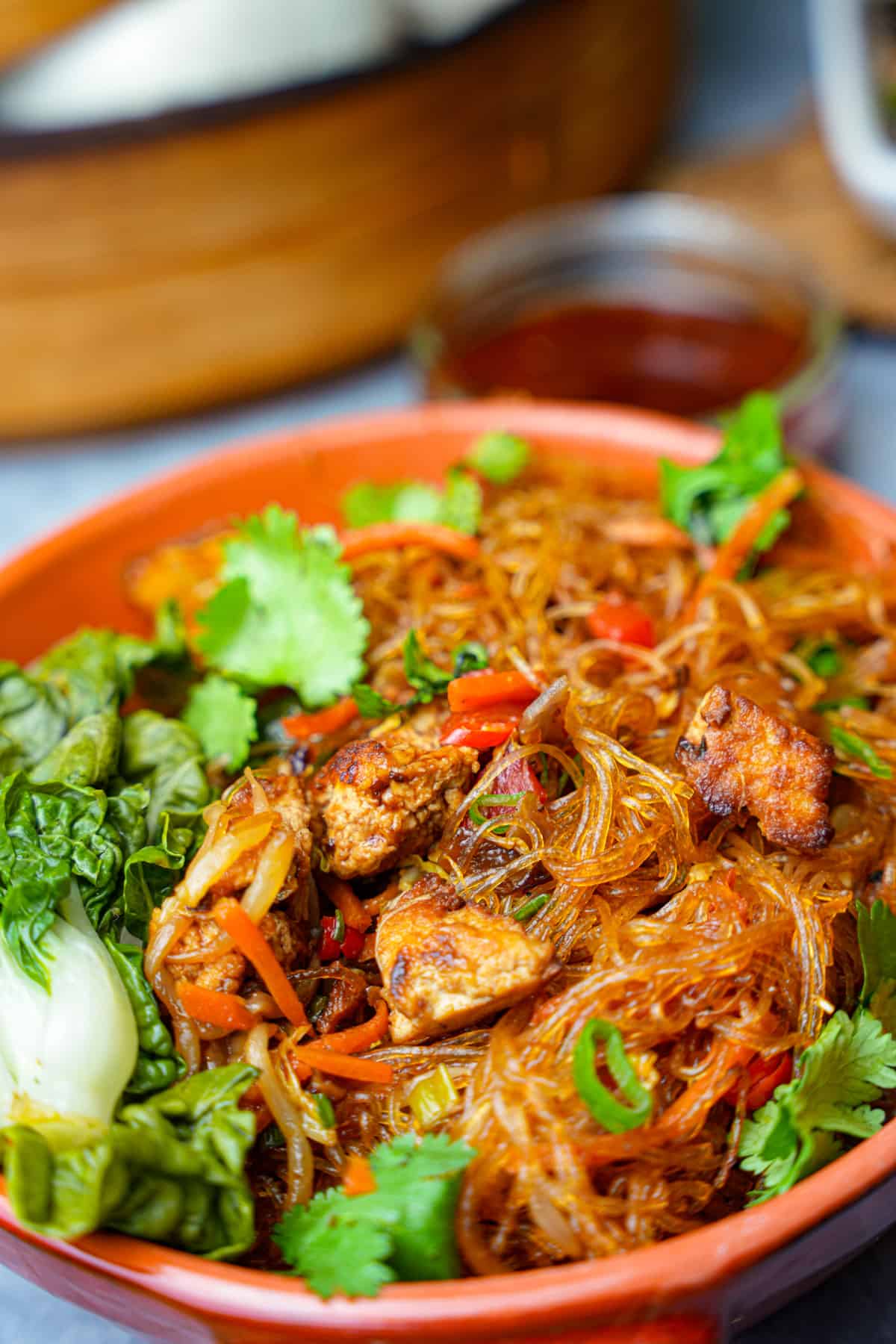
Step 7
Place the contents of the pan into an attractive serving dish and garnish with fresh cilantro leaves, minced bird's eye chilies, sliced scallions, and lime wedges.
💡Serving Ideas
A nice big bowl of this is a national treasure of my heart on its own. But you could totally turn this into an even more well-rounded meal by serving it with my crispy rice dumplings, Indonesian vegetable and coconut milk stew, pickled burdock, or some spicy marinated cucumbers on the side.
You can top the noodles with sambal goreng, tofu katsu, miso glazed eggplant or seitan bulgogi.
Don't skip dessert- make these thick chocolate and peanut-stuffed Indonesian pancakes: martabak manis. Coconut-stuffed pandan crepes? Word up. Or serve a classic Vietnamese dessert after these noods such as Chè Ba Màu or Banh Flan.
👉Top tip
- Don’t turn your noodles into terrible mush: When using bean thread noodles, be sure to soak them in hot water according to the package instructions until they are pliable but not overly soft. Over-soaking (or worse - BOILING the noodles instead of soaking them) can result in mushy noodles, so keep an eye on them while soaking and drain them promptly when ready. If they are ready before you are ready for them, massage the drained noodles with a bit of cooking oil to prevent them from sticking together while waiting for your slow-ass to catch up with them.
- Stir-fry in small batches: Cook the ingredients in small batches to ensure that they cook evenly and get nice browning. Overcrowding can result in steaming instead of stir-frying, which can lead to soggy vegetables.
🤷♀️Recipe FAQs
Pad Woon Sen and Pad See Ew are both popular Thai noodle dishes, but they are not the same thing at all!
Pad Woon Sen translates to stir-fried glass noodles or stir-fried bean thread noodles in Thai. Pad refers to the stir-frying cooking method, while Woon Sen or Woonsen refers to the glass noodles made from mung bean starch.
Pad See Ew translates to stir-fried soy sauce noodles in Thai. Pad again refers to the stir-frying cooking method, while See Ew or Si Ew refers to the dark soy sauce used in the dish, which gives it its distinct flavor and color.
Pad Woon Sen uses transparent bean thread noodles, has a lighter and more delicate flavor, and includes a variety of vegetables. It is typically stir-fried quickly in a hot wok or pan. On the other hand, Pad See Ew uses wide rice noodles, has a richer and slightly sweeter flavor, and commonly includes Chinese broccoli.
Pad Woon Sen can be made vegan or vegetarian by using plant-based protein sources such as tofu or seitan and using vegetable or mushroom-based sauces instead of fish sauce or oyster sauce. However, it's important to note that traditionally prepared Pad Woon Sen often contains animal-derived ingredients, such as meat or fish-based sauces, particularly in restaurants.
As for gluten-free, Pad Woon Sen can be made gluten-free by using gluten-free bean thread noodles or other gluten-free alternatives, and by using gluten-free soy sauce or tamari sauce as a substitute for regular soy sauce. It's important to read labels and choose gluten-free ingredients to ensure the dish is safe for those with gluten sensitivities or celiac disease.
🥶Refrigeration:
Allow the Pad Woon Sen to cool to room temperature. Transfer it to an airtight container and store it in the refrigerator for up to four days. It's best to store the noodles and vegetables separately from the sauce to prevent the noodles from becoming too soft or soggy.
Reheating:
☢️Into the microwave inferno you go: Use a microwave-safe dish and microwave it on high in 30-second intervals, stirring in between, until heated through.
🔥Reheat on the stovetop: Heat a pan or wok over medium-high heat, add a little oil, and then add the Pad Woon Sen. Stir-fry for a few minutes, stirring occasionally, until heated through.
💧Adjustments: If the Pad Woon Sen seems too dry after reheating, add a splash of water or a little extra sauce to moisten it up.
Be sure to taste and adjust the seasoning as needed, adding more soy sauce, vegan oyster sauce, or other seasonings to suit your preference. Just like when serving fresh, it’s nice to garnish the reheated Pad Woon Sen with cilantro, green onions, lime wedges, and chili flakes or sliced fresh chili for an extra burst of flavor and freshness.
✌️Other dishes that go great with pad woon sen:
Say Hi on Social! 👋
Follow me on Instagram & Facebook for more recipes.
❤️Love this recipe? It helps me out greatly if you leave a 5-star 🌟🌟🌟🌟🌟rating in the recipe card below and maybe even leave me a lovey-dovey comment too!
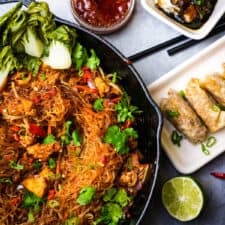
Pad woon sen (Thai stir-fried glass noodles)
Equipment
Ingredients
Stir-fried noodles and veggies
- 150 grams about 5.3 oz. dried bean thread noodles (a.k.a. glass noodles)
- 3 tablespoons canola oil or vegetable oil
- ½ of a 14 oz. block of firm tofu hand torn into small pieces
- ⅔ cup chopped red onion
- 3 cloves garlic minced
- 1 cup carrots julienne cut, or shredded
- ½ red bell pepper thinly sliced
- 1 cup shredded Napa cabbage
- 2 small tomatoes cut into wedges
- 2 cups bean sprouts
- 2 sliced bird’s eye chilies Thai chilies
- 2 scallions cut into 1 cm. sections
Sauce
- 2 tablespoons tamari
- 3 tablespoons vegetarian oyster sauce
- 1 tablespoon rice vinegar
- 4 teaspoons sugar
- 3 tablespoons water
- ¼ teaspoon white pepper
Garnish
- Fresh cilantro leaves
- 2 minced bird’s eye chilies Thai chilies
- 1 scallion thinly sliced
- Lime wedges
Instructions
- Prepare the dried bean thread noodles by soaking them in warm water for 8-10 minutes until pliable. Drain them in a colander and set aside.
- Heat the canola oil or vegetable oil in a large wok or pan over high heat.
- Add the torn tofu to the pan and stir-fry for 8-9 minutes until lightly golden and crispy.
- Lower the flame to medium and add the minced garlic and red onion. Stir-fry with the tofu for 2-3 minutes until fragrant.
- Add the julienne-cut carrots, sliced red bell pepper, shredded Napa cabbage, tomatoes, bean sprouts, bird's eye chilies, and scallions to the pan. Stir-fry for another 3-4 minutes until the vegetables are slightly softened.
- In a small bowl, whisk together the tamari, vegan oyster sauce, rice vinegar, sugar, water, and ground white pepper to make the sauce.
- Pour the sauce over the vegetables in the pan and add the cooked bean thread noodles. Stir-fry everything together for another 2-3 minutes until the noodles are heated through and the sauce is well distributed.
- Remove from heat and garnish with fresh cilantro leaves, minced bird's eye chilies, sliced scallions, and lime wedges before serving.
Notes

Enter your email & I'll send it to your inbox. Plus, get great new recipes from me every week!
By submitting this form, you consent to receive emails from Cinnamon Snail.

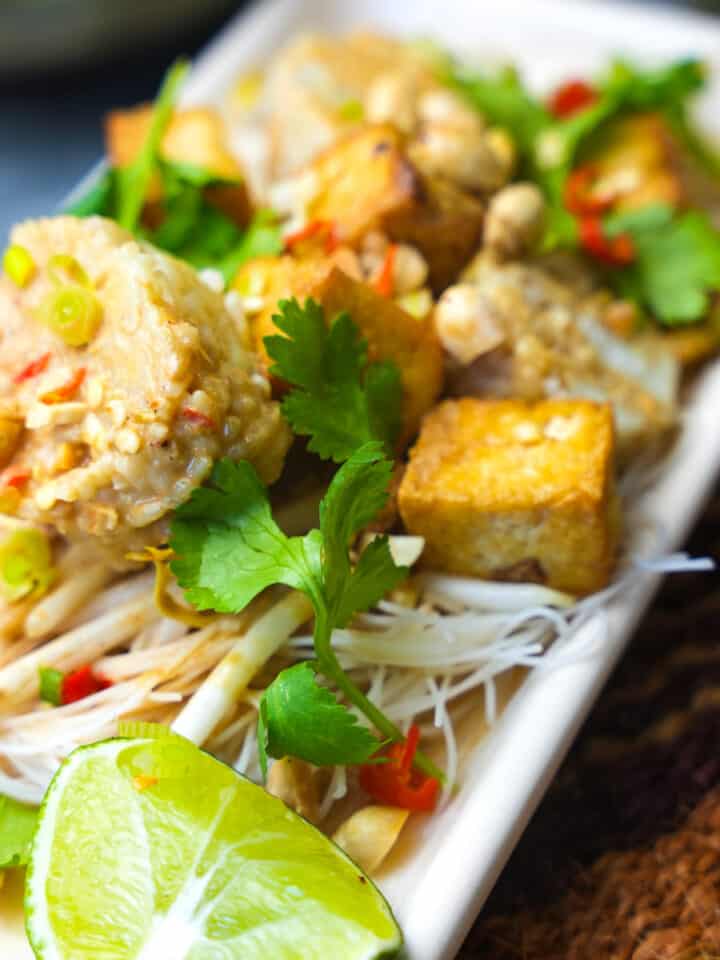
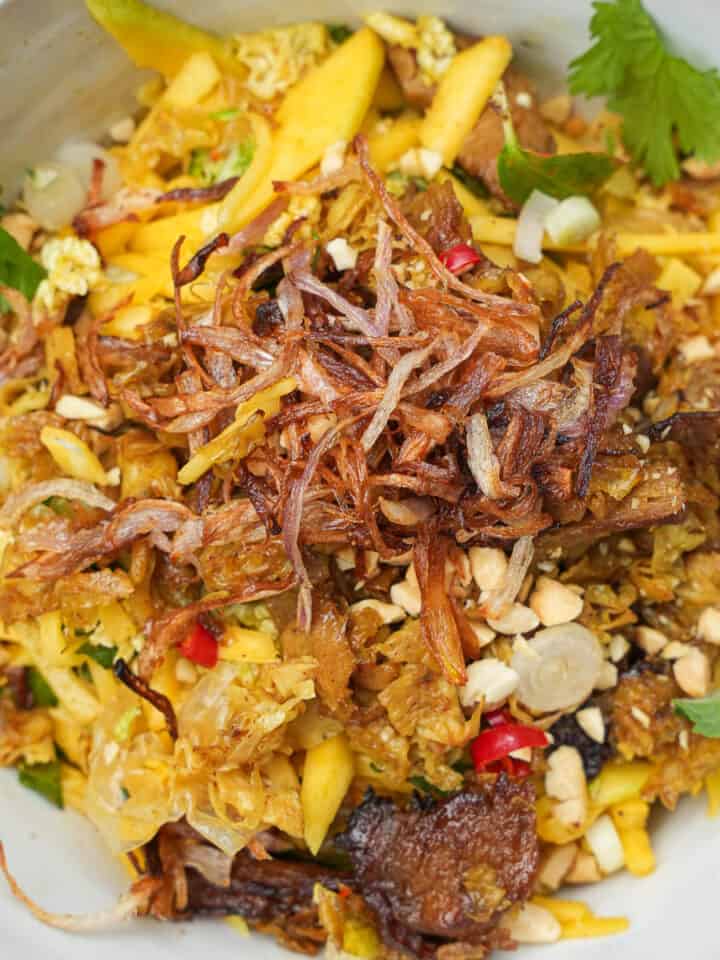
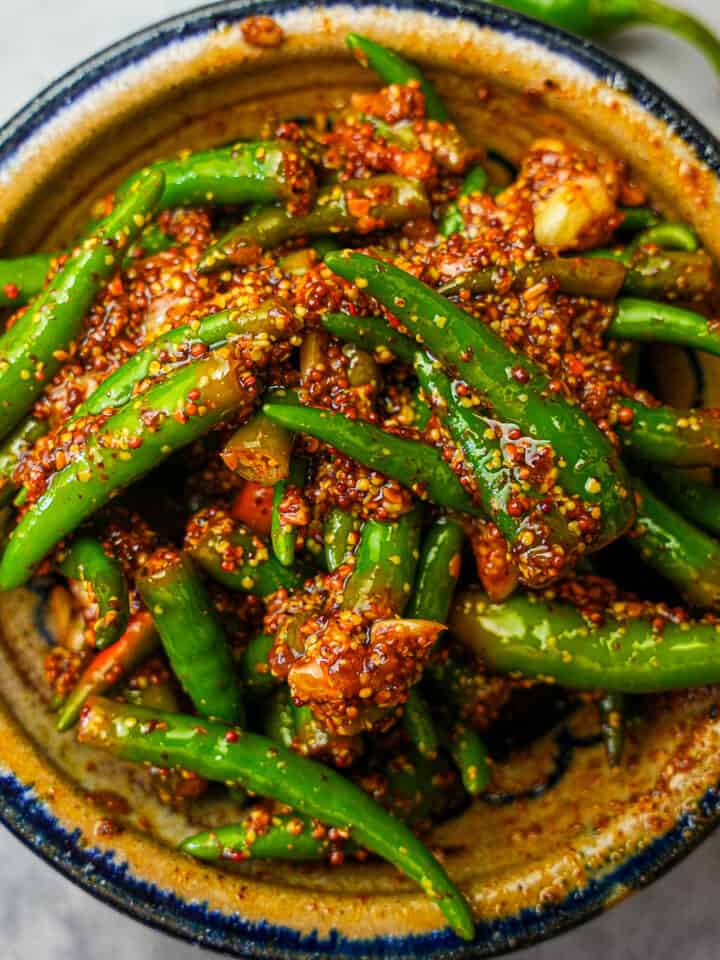
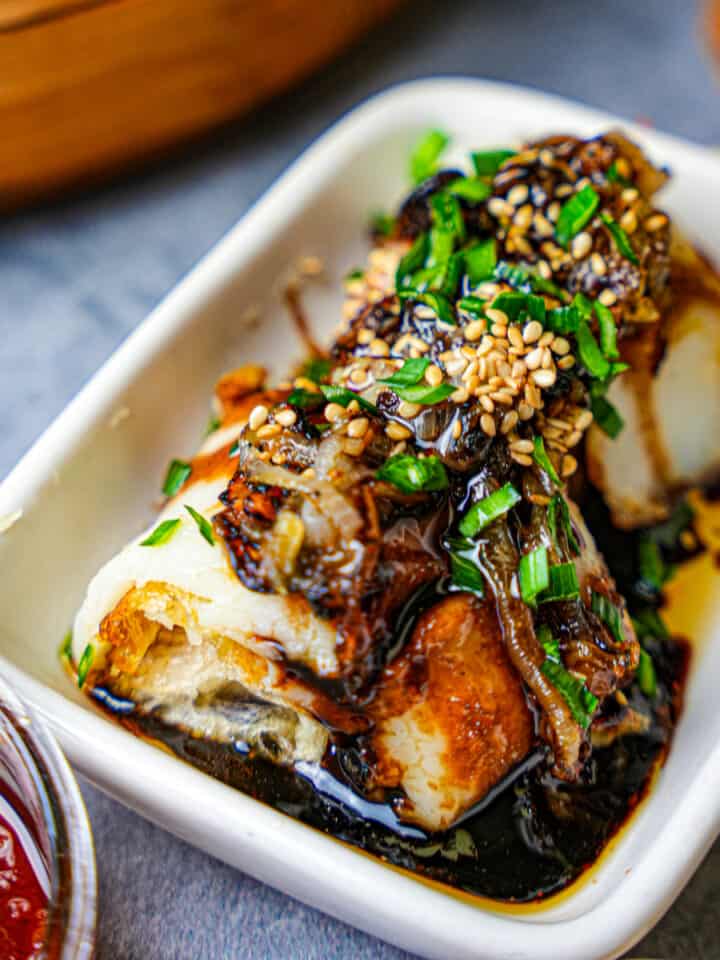






Meg says
Oh this was so good! And easy. Instructions so clear. I added a dab of your Tom yum paste, as suggested and this gave it a great extra zing. Thanks Chef Adam.
Sarah says
This was so yummy I went back for seconds. The sauce is the bomb!
HG says
Another great tasting, easy recipe to make. A great dish to make when you're getting bored of the same old stuff. Took my Asian cooking in a whole new, exciting direction.
Tina Nguyen says
Great recipe. It was a hit among friends!!
Liz M says
Another great recipe! The flavors were great and we kicked it up a notch by adding extra chilies.
Adam Sobel says
'tis exactly what I would do too ❤️